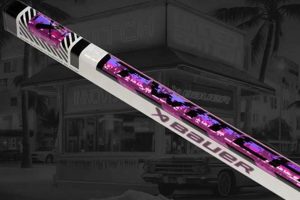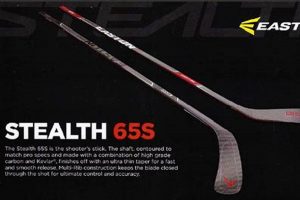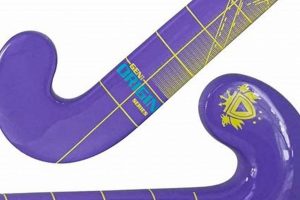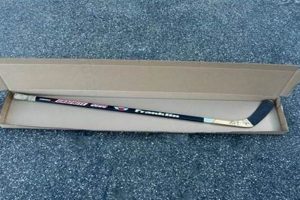The material used in the construction of a hockey stick significantly influences its performance, durability, and feel. Traditionally, a specific type of tree was favored for its inherent qualities of strength, flexibility, and weight. Ash and birch, for example, were frequently selected due to their ability to withstand the rigors of gameplay and provide a responsive feel for the player. The choice of material directly affects the stick’s ability to transfer energy during a shot and absorb impacts from pucks and other players.
The adoption of these materials in hockey stick manufacturing stemmed from their natural abundance, workability, and relatively low cost. Historically, individual craftsmen and later, manufacturing companies, relied on these resources to produce equipment accessible to a wide range of players. The material’s inherent properties played a crucial role in the evolution of hockey equipment and the development of player skills, influencing stick handling techniques and shooting styles.
Modern advancements have introduced alternative materials into hockey stick production. These innovations aim to enhance performance characteristics and improve durability while addressing the sustainability of resource utilization. The following sections will delve into these advancements and explore the comparative advantages and disadvantages of traditional and contemporary materials used in hockey stick manufacturing.
Tips for Maintaining Hockey Stick Integrity
Maintaining the structural integrity of hockey sticks is crucial for optimal performance and safety. Proper care extends the lifespan of the equipment and ensures consistent performance during gameplay.
Tip 1: Store Properly: Store hockey sticks in a dry environment, away from direct sunlight and extreme temperatures. This prevents warping and degradation of the material. Laying sticks flat or hanging them vertically avoids putting undue stress on specific points.
Tip 2: Tape Strategically: Apply tape to the blade and handle to protect against abrasion and moisture absorption. Overlapping tape layers provide enhanced durability and grip. Regularly replace worn tape to maintain optimal stick handling and shooting control.
Tip 3: Inspect Regularly: Conduct routine visual inspections for cracks, splinters, or other signs of damage. Pay particular attention to high-stress areas such as the blade, shaft, and heel. Early detection of damage allows for timely repair or replacement, preventing catastrophic failure during gameplay.
Tip 4: Avoid Excessive Force: Refrain from using excessive force when striking the ice or boards. This minimizes the risk of impact-related damage and prolongs the stick’s lifespan. Emphasize proper technique to reduce stress on the equipment.
Tip 5: Consider Reinforcement: Reinforce vulnerable areas, such as the blade heel, with protective coatings or specialized tape designed to withstand impact and abrasion. This provides an additional layer of protection against common types of damage.
Tip 6: Control Humidity: Wooden implements are susceptible to changes in humidity, which can affect their weight and performance. Use a dehumidifier in the storage area to maintain consistent moisture levels.
Adherence to these maintenance practices will preserve the integrity and performance characteristics of hockey sticks, enhancing both the player’s experience and safety on the ice.
The following sections will discuss methods for repairing minor damage and determining when replacement is necessary.
1. Flexibility
Flexibility in a hockey stick, particularly when constructed from wood, is a critical determinant of shooting power and puck control. The ability of the stick to bend under load allows the player to store potential energy during the loading phase of a shot. This stored energy is then released upon impact with the puck, contributing to increased puck velocity. The inherent flexibility of the timber used directly influences the amount of energy that can be stored and the speed at which it is released. For instance, a stick crafted from a highly flexible type might allow for a deeper load and a more powerful shot, while a stiffer stick might offer greater accuracy but less power.
The connection between material composition and flexibility is evident in the performance characteristics of different types of wood. Ash, traditionally a popular choice, exhibits a moderate degree of flexibility, providing a balance between power and control. Birch, another common material, tends to be more flexible than ash, offering enhanced energy storage but potentially sacrificing some degree of accuracy. The specific grain orientation and density of the timber further modify its bending properties, adding layers of complexity to the selection process. Moreover, consistent flexibility throughout the lifespan of the wooden hockey stick requires careful drying and processing to prevent warping or structural degradation.
Understanding the interplay between material composition, manufacturing processes, and flexibility is essential for optimizing hockey stick performance. While modern composite materials offer alternative flex characteristics, the inherent feel and flex patterns of hockey stick wood continue to be valued by some players. Precise control over flexibility ensures that energy is transferred efficiently and effectively, enhancing the player’s ability to generate powerful shots and maintain precise control over the puck. Therefore, flexibility remains a vital consideration in the design and selection of these pieces of sporting equipment.
2. Strength
Structural integrity, specifically the strength of hockey stick wood, is paramount for withstanding the high-impact forces encountered during gameplay. A stick’s ability to resist breakage and maintain its form directly influences a player’s performance and safety.
- Tensile Strength
Tensile strength, the ability to resist being pulled apart, is crucial in a hockey stick’s shaft. During a slap shot, the shaft experiences significant tensile forces as the player bends the stick. A wood with high tensile strength, such as ash, is less likely to fracture under this stress, ensuring the stick can effectively transfer energy to the puck.
- Impact Resistance
Impact resistance refers to the wood’s capacity to absorb sudden shocks without fracturing. Hockey sticks are repeatedly subjected to impacts from pucks, other players’ sticks, and the boards. Dense, close-grained woods offer superior impact resistance, preventing splintering and structural failure.
- Flexural Strength
Flexural strength, or bending strength, is vital for the blade of a hockey stick. As the blade strikes the puck, it undergoes bending forces. A high flexural strength allows the blade to maintain its shape and efficiently transfer energy, enhancing shot accuracy and power. Woods with interlocking grain patterns exhibit greater flexural strength.
- Shear Strength
Shear strength, the ability to resist forces that cause layers to slide against each other, is important at the joint between the shaft and blade. This area experiences shear forces during forceful shots. Strong adhesives and proper wood grain orientation are essential to maximize shear strength and prevent separation of the blade from the shaft.
The overall strength of a hockey stick constructed from wood is a composite of these individual strength characteristics. Selection of appropriate wood species, careful attention to grain orientation during manufacturing, and proper maintenance all contribute to a hockey stick that can withstand the demands of competitive play. The pursuit of enhanced strength in hockey stick materials remains a driving force in the evolution of hockey equipment.
3. Weight
The mass of hockey stick wood directly affects a player’s ability to handle the stick swiftly and efficiently. A lighter stick allows for quicker wrist movements and faster stick handling, enhancing puck control and shot release speed. Conversely, a heavier stick may provide more power behind shots due to the increased momentum, but can reduce maneuverability and contribute to player fatigue over extended periods of play. Therefore, the weight of the wood selected is a critical factor influencing a player’s on-ice performance.
Historically, the choice of timber species reflected a trade-off between strength and weight. Ash, a commonly used wood, offered a reasonable balance. However, lighter woods, while potentially increasing agility, often lacked the necessary durability to withstand the rigors of the game. Modern manufacturing techniques attempt to mitigate this compromise through careful selection of wood density and innovative construction methods. For instance, hollowing out portions of the stick’s core or reinforcing specific areas with composite materials can reduce overall weight without sacrificing structural integrity. Furthermore, the application of lightweight varnishes and finishes minimizes added mass while protecting the wood from moisture and abrasion. Real-world examples include professional players often customizing their sticks, sanding down the shaft to reduce weight and improve feel.
The relationship between weight and performance in hockey sticks is complex and highly individualized. While lighter sticks generally enhance stick handling speed and reduce fatigue, the ideal weight ultimately depends on a player’s strength, skill level, and playing style. Manufacturers continue to explore novel material combinations and construction techniques to optimize weight distribution and create sticks that cater to a wide range of player preferences. Balancing the need for lightness with the demands of strength and durability remains a central challenge in the ongoing evolution of hockey stick design and material selection.
4. Durability
The longevity of a hockey stick fabricated from wood is a primary concern for players at all levels. The capacity of the wood to withstand repeated impacts, stress, and environmental factors dictates its useful lifespan and overall value.
- Wood Density and Grain Structure
The inherent density of the wood and the orientation of its grain significantly influence its resistance to fracture and wear. Denser woods, such as ash, offer greater impact resistance compared to lighter, less dense varieties. A tight, interlocking grain pattern distributes stress more evenly, minimizing the risk of splintering and breakage. The careful selection and processing of lumber to optimize these characteristics is paramount in ensuring a durable product.
- Environmental Factors
Exposure to moisture and temperature fluctuations can compromise the structural integrity of hockey stick wood. Moisture absorption leads to swelling and weakening of the wood fibers, increasing the likelihood of warping and cracking. Extreme temperature variations can cause expansion and contraction, placing undue stress on the material. Proper storage in a dry, climate-controlled environment mitigates these effects, extending the stick’s usable life. Routine maintenance, such as sealing the wood with water-resistant coatings, provides an additional layer of protection.
- Frequency and Intensity of Use
The rate at which a wooden hockey stick degrades is directly related to the frequency and intensity of its use. A stick subjected to daily, high-impact play will inevitably exhibit wear and tear more rapidly than one used less frequently or in lower-intensity settings. The forces generated during slap shots, board collisions, and puck impacts gradually weaken the wood fibers, leading to eventual failure. Professional players, who subject their sticks to extreme stress, often require frequent replacements.
- Manufacturing Processes and Adhesives
The methods employed during manufacturing, including the lamination techniques and the quality of adhesives used, play a crucial role in determining the overall durability of the wooden hockey stick. Properly laminated sticks, where thin layers of wood are bonded together with strong adhesives, exhibit greater resistance to cracking and warping compared to single-piece constructions. The use of high-quality, water-resistant adhesives prevents delamination and maintains structural integrity even under wet conditions. Precise manufacturing processes ensure consistent quality and minimize potential weak points in the stick’s construction.
The interplay of these factorswood properties, environmental conditions, usage patterns, and manufacturing techniquesultimately determines the durability and lifespan of a hockey stick constructed from wood. Understanding these interdependencies allows players and manufacturers to optimize stick performance and longevity, balancing cost considerations with the demands of the game.
5. Responsiveness
Responsiveness, in the context of hockey stick wood, refers to the stick’s capacity to transmit tactile feedback and energy efficiently between the player’s hands and the puck. This characteristic allows for heightened puck control, precise shot placement, and an enhanced sense of connection during gameplay.
- Vibration Dampening and Signal Transmission
Wood possesses inherent vibration-dampening properties that filter out harsh vibrations while still allowing subtle tactile signals to reach the player’s hands. This balance enables the player to perceive the puck’s location on the blade and make minute adjustments to control and trajectory. A highly responsive stick wood provides a clear “feel” for the puck, enhancing overall control.
- Energy Transfer Efficiency
The density and grain structure of the wood influence its ability to transfer energy from the player’s body to the puck during a shot. A responsive wood efficiently converts kinetic energy into puck velocity, maximizing shot power. Less responsive materials may absorb a greater percentage of the energy, resulting in a weaker shot. The selection of wood and manufacturing processes directly impact the energy transfer efficiency.
- Flex Profile and Kick Point Feedback
A responsive hockey stick provides discernible feedback regarding its flex profile and kick point during the loading and release phases of a shot. This feedback allows the player to fine-tune technique and timing to maximize shot accuracy and power. Players develop a sense of the stick “loading up” and releasing energy, enabling them to anticipate and control shot characteristics. This is why many prefer a certain feel to the stick.
- Blade Feel and Puck Control
The blade’s construction and material composition dictate its sensitivity to the puck. A responsive blade allows the player to “feel” the puck against the ice, enabling precise puck handling and passing. This heightened sensitivity allows for quick adjustments and greater control over the puck’s movement. Responsive blades provide a tactile advantage during stickhandling and puck battles.
The integration of these facets creates a holistic understanding of responsiveness in hockey stick wood. The wood’s capacity to dampen vibrations, efficiently transfer energy, provide flex feedback, and enhance blade feel contributes to a superior level of puck control and overall performance. These characteristics, valued by players of all skill levels, underscore the importance of material selection and design in hockey stick manufacturing. As the game evolves, responsive wood remains a favored option for stick design.
6. Grain Orientation
The orientation of wood grain within a hockey stick profoundly influences its strength, flexibility, and overall performance. Proper grain alignment ensures that the wood’s natural fibers run parallel to the longitudinal axis of the stick, maximizing its resistance to bending and impact forces. Conversely, misaligned or inconsistent grain can create weak points, predisposing the stick to premature failure. For instance, if the grain runs diagonally across the shaft, the stick will be more prone to snapping under the stress of a forceful shot.
The specific orientation dictates how forces distribute throughout the wood. A straight grain allows energy to transfer efficiently from the player’s hands to the puck, optimizing shot power and accuracy. Furthermore, consistent grain orientation helps to maintain the stick’s flex profile, enabling predictable and repeatable performance. Hockey stick manufacturers often employ specialized cutting and lamination techniques to ensure optimal grain alignment in the finished product. This process involves carefully selecting and orienting individual wood plies to create a composite structure with superior strength and responsiveness. An example of this is seen in laminated sticks, where thin layers of wood with strategically aligned grain are bonded together, enhancing overall durability.
Ultimately, the careful consideration and manipulation of grain orientation represent a critical aspect of hockey stick design and construction. Understanding this relationship between wood grain and performance enables players to make informed equipment choices and manufacturers to produce more durable and effective hockey sticks. Addressing challenges in maintaining consistent grain alignment, particularly in mass production, remains a key area of ongoing research and development within the industry. The careful alignment and selection of wood grains impact the stick’s overall performance.
Frequently Asked Questions About Hockey Stick Wood
This section addresses common inquiries regarding the material composition and performance characteristics of hockey sticks constructed from wood.
Question 1: What types of wood are traditionally used in hockey stick manufacturing?
Ash and birch are commonly employed due to their balance of strength, flexibility, and availability. Other wood types, such as maple and aspen, may be used, although less frequently.
Question 2: How does wood grain orientation affect hockey stick performance?
Proper grain alignment, running parallel to the stick’s longitudinal axis, is crucial for maximizing strength and preventing breakage. Misaligned grain can create weak points and compromise durability.
Question 3: What are the primary advantages of wood hockey sticks compared to composite sticks?
Wood sticks typically offer a more responsive feel and enhanced tactile feedback, allowing for greater puck control. They may also be more affordable than high-end composite models.
Question 4: How should wood hockey sticks be stored to prevent damage?
Store wood sticks in a dry, climate-controlled environment away from direct sunlight and extreme temperatures. This prevents warping, cracking, and degradation of the wood.
Question 5: What are the common signs that a wood hockey stick needs to be replaced?
Look for cracks, splinters, excessive warping, or a noticeable decrease in flex and responsiveness. These indicate structural weakening and potential for failure.
Question 6: Can a broken wood hockey stick be repaired effectively?
While minor damage may be repaired using specialized adhesives and reinforcement techniques, extensive damage typically warrants replacement, as the stick’s structural integrity is compromised.
In summary, understanding the properties, maintenance requirements, and limitations of hockey stick wood is essential for optimizing performance and ensuring player safety.
The subsequent section will explore the evolution of hockey stick materials and manufacturing processes.
Conclusion
The preceding exploration has elucidated the inherent characteristics and performance implications of hockey stick wood. From the traditional reliance on ash and birch to the nuanced understanding of grain orientation and density, the properties of the wood material exert a significant influence on a player’s experience. The discussion encompassed the material’s flexibility, strength, weight, durability, and responsiveness, emphasizing the critical role each plays in translating player input into on-ice action. Maintaining this construction and ensuring the wood itself is durable are paramount to extending its usable lifespan.
While advancements in composite materials have presented alternatives, hockey stick wood retains its significance due to its unique tactile feedback and affordability. Continued research and refinement of wood selection and manufacturing processes will likely ensure its continued relevance within the evolving landscape of hockey equipment. Therefore, a comprehensive understanding of the material remains crucial for both players and manufacturers seeking to optimize performance and maintain the integrity of the sport.







